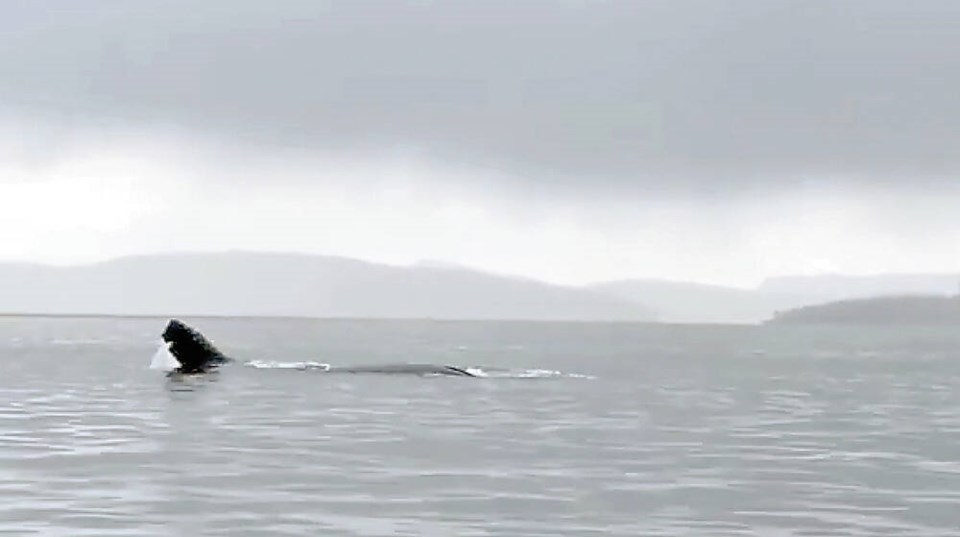A spunky humpback, aptly known as Valiant, escaped what could have been a violent attack by a group of nine transient killer whales in the Salish Sea by using its own form of aggressive behaviour.
The dramatic scene played out Tuesday afternoon for about 20 minutes in the southern Strait of Georgia, directly in the lane of a sa国际传媒 Ferries vessel heading out from Tsawwassen.
Whale-watching vessels, including a boat from Victoria’s Prince of Whales, called in the encounter and the ferry changed its course.
Five-year-old Valiant, whose sex still hasn’t been determined, was seen by whale watchers surrounded and harassed by nine Bigg’s orcas in two hunting families, said Erin Gless of the Pacific Whale Watch Association.
But the humpback was able to ward off the pods by rolling around and trumpeting with each surfacing, “a behaviour associated with aggression in humpback whales,” according to a naturalist aboard one of the two boats at the scene.
It isn’t Valiant’s first documented run-in with Bigg’s killer whales. At age two on July 11, 2019, Valiant was seen “chasing after” a group of Bigg’s killer whales in the Strait of Juan de Fuca until the orcas left the area.
On June 26 last year, Victoria-based Eagle Wing Tours observed Bigg’s killer whale T125A, a large male, pushing Valiant as some younger orcas attempted to get on top of the whale, but Valiant turned sharply and went on the offensive, chasing the group off.
Gless said the “extreme scarring” on Valiant’s tail suggests the whale might have survived a brutal orca attack at just a few months old.
“Did that initial encounter shape the way Valiant interacts with orcas today? The message is pretty clear — don’t mess with Valiant,” said Gless.
Transient orcas — the largest species in the dolphin family — eat seals and sea lions and will hunt and eat younger whale calves, said Gless.
Scientists have shown in studies on both coasts of North America that orcas are also known to harass adult humpbacks — and even grab a quick chunk of meat off them.
Orcas would seem to have the advantage of superior speed and teeth. Humpbacks, which are baleen whales, don’t have teeth. Instead, they use baleen — a series of bristly fringed plates — to filter krill and other food from the water.
But humpbacks are no pushovers, said Gless.
Adult humpbacks weigh between 30 and 50 tonnes, some growing up to 15 metres in length, said Gless.
A humpback’s tail is extremely powerful, and its pectoral flippers are the largest of any whale, measuring up to five metres long.
Often encrusted with sharp barnacles, the flippers are another deterrent against orca attacks, said Gless. The aggressive trumpeting, or short, sharp bursts of breathing, are also noted in the breeding ground when males vie for females.
Gless said based on the documented scars on the tails of humpbacks in the Salish Sea, at least 25 per cent have had encounters with orcas at some point in their lives, usually at a young age.
But even as humpbacks grow older and heavier, orca attacks do happen, she said.
Humpbacks consider orcas an arch enemy, said Gless.
“There have been many documented cases around the world of humpbacks protecting other types of whales,” she said.
“Our [whale-watching] members have also seen humpbacks stopping orca sea lion hunts.”
Gless said whether the humpbacks are trying to help other mammals or acting aggressively for self-preservation is unknown.
In 2016, a team of researchers from Oregon State University found 30 cases from around the world in which humpbacks attacked orcas when they were pursuing whales and other mammals.
“The humpback whale is, to our knowledge, the only cetacean that deliberately approaches attacking mammal-eating killer whales and can drive them off,” said Dr. Robert Pitman, a marine ecologist and co-author of the report.
“We suggest that the evolution of the humpback’s massive pectoral flippers may have given it an advantage over killer whales and perhaps altered the balance of power in their interactions.”
The Oregon State paper said the humpback’s formidable appendages, when used in concert with the flukes, “afford humpbacks with fore and aft, offensive and defensive weaponry — a capability that is unique among living baleen whales.”
The incident this week comes after whale watchers report record numbers of Bigg’s orca and humpback sightings in the Salish Sea over the past year.
Note to readers: This story has been corrected. A previous version contained incorrect information about the size of humpbacks and the anatomy of humpbacks and orcas.




